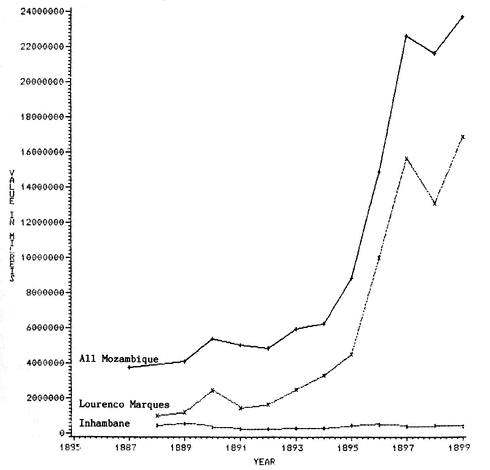Southern Mozambique in the Late Nineteenth Century Regional Economy
Paradoxically, the area in which this self-consciously Portuguese-speaking black elite had grown up was one which had wavered in the margins of Portuguese consciousness and control for centuries. It was only in the last quarter of the nineteenth century that significant and sustained links between Lisbon and Lourenço Marques were established.[7] Before this, the town and its hinterland were oriented towards the Indian Ocean and southeastern African trade worlds, having only rare contact with Lisbon.[8] The flow of persons and goods in the town's economic hinterland usually proceeded oblivious to metropolitan interests—untaxed, unsanctioned and producing little revenue for chronically empty state coffers.
Smuggling was so pervasive in southern Mozambique that Portuguese officials hesitated to try to increase customs duties, fearing that higher duties would only drive all trade outside the customs house.[9] Lisbon was equally frustrated by its inability to sell Portuguese goods in the area because of competition from Indian Ocean traders. Lisbon began seriously to address the problem of controlling the trade of southern Mozambique only in the 1870s, at a time when the state's coffers were particularly empty and when the trade of Lourenço Marques was beginning to appear especially alluring. Reining in Mozambique's economy, however, proved difficult.
Portugal began trying to raise revenues by strengthening its economic links with its African colonies. It determined to encourage an increase in the volume of Mozambique's foreign trade, hoping that it would generate greater customs and handling revenues. In 1877 Portugal opened Mozambican commerce and shipping to all countries. Between 1877 and 1892 the value of legal foreign trade in Mozambique increased by 300 per cent.[10] Yet, while foreign trade grew, Portugal's own trading position remained weak. In 1885, for example, the bulk of Mozambique's trade was in British or British Indian hands, with Portugal controlling a mere 7 per cent of the total value.[11] At the same time, southern Mozambique was also rapidly being drawn into the developing regional economy based on the sugar plantations of Natal and, most importantly, the mineral deposits of the Transvaal.
In the early 1890s Portugal underwent a severe economic crisis that prompted the government to reassess its liberal colonial tariff policies. As a consequence, in 1892, it promulgated protectionist measures that established throughout most of Mozambique a wide-ranging set of import and export duties designed to raise revenue. Lourenço Marques district, however, was specifically exempted from the new duties lest they drive its commerce into adjacent British territory.[12] As a result of this exemption, the value of Mozambique's trade in foreign hands, dominated especially by the rapidly growing trade through the port of Lourenço Marques to and from the Transvaal, continued to grow unabated, increasing
another fivefold between 1892 and 1899.[13] In 1880, customs revenues from the District of Lourenço Marques amounted to 47,000 milreis, while in 1896 they contributed 600,000 milreis in revenues.[14]
It was this commercial vigour that set Lourenço Marques apart from other Mozambican ports. In central Mozambique's Zambezia area, for example, the new Portuguese tariff policies throttled a promising experiment in peasant agriculture, bringing about a drop in the value of exports between 1891 and 1901 of some 80 per cent.[15] In Inhambane, to the north of Lourenço Marques, where itinerant trade from the hinterland comprised the bulk of export commodities, trade similarly languished throughout the 1890s. By 1899 Inhambane's overseas trade was 30 per cent less valuable than it had been a decade earlier. Lourenço Marques, however, with its firm linkages to the Witwatersrand gold fields and its exemption from the new protectionist tariffs, enjoyed a trade boom.[16]
The movement of people also drew southern Mozambique into the wider regional economy. From the 1860s on, but increasingly from the 1870s and 1880s, Mozambican men sold their labour in the growing capitalist economy of South Africa and fuelled local trade with repatriated wages.[17] Clearly, the economy of Lourenço Marques had taken an important and decisive turn in the last three

Figure 9.1
Trade in late nineteenth century Mozambique. Total value import/export in milreis.
decades of the nineteenth century. If Portugal was to maximize its revenues from this new situation, it would have to develop initiatives quite different from the essentially mercantile tactics it was then applying in Angola. The new policies were to have a far-reaching impact upon the area's local elite.